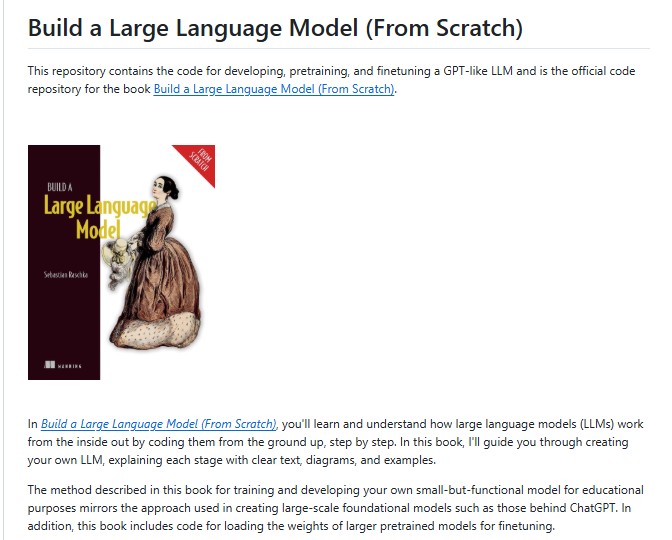In recent years, Large Language Models (LLMs) have revolutionized the world of Artificial Intelligence (AI). From ChatGPT and Claude to Llama and Mistral, these models power the conversational systems, copilots, and generative tools that dominate today’s AI landscape. However, for most developers and learners, the inner workings of these systems remain a mystery until now.

Sebastian Raschka’s book Build a Large Language Model From Scratch breaks that barrier. The book and its open-source companion repository on GitHub (rasbt/LLMs-from-scratch) guide readers through the complete process of building, pretraining and fine-tuning a GPT-style model from the ground up. No shortcuts, no magic just clear explanations, detailed code and a hands-on approach.
In this blog, we’ll explore what this project covers, its structure chapter by chapter and why it’s one of the most valuable learning resources for anyone passionate about AI and machine learning.
What is “Build a Large Language Model From Scratch” About?
The book and repository take you behind the scenes of how LLMs like GPT-3 and GPT-4 are designed. You’ll learn to code your own transformer-based model using PyTorch, train it on text data, fine-tune it for tasks such as classification and instruction-following, and even experiment with extensions like LoRA for parameter-efficient finetuning.
Instead of relying on prebuilt LLM frameworks, Raschka helps readers understand the core building blocks from tokenization to attention mechanisms, from training loops to optimization. This approach ensures you not only use LLMs effectively but also understand how they work internally.
Who is This Book For?
The project is ideal for:
- AI enthusiasts who want to dive deep into transformer architectures.
- Machine learning students seeking a practical way to understand large model training.
- Python and PyTorch developers interested in experimenting with LLMs.
- Researchers and educators looking for a structured, open-source learning guide.
Basic familiarity with Python and neural networks is helpful but even beginners can follow along thanks to the clear explanations and exercises provided in each chapter.
Chapter Overview
Here’s a breakdown of the core chapters and appendices included in the book and GitHub repository:
Chapter 1: Understanding Large Language Models
A conceptual introduction to how LLMs work including tokenization, embeddings, attention and transformer architecture. This chapter builds the mental model necessary to grasp the mechanics of text generation.
Chapter 2: Working with Text Data
Learn how to handle and preprocess text datasets efficiently. You’ll implement a Byte Pair Encoding (BPE) tokenizer from scratch and understand how data loaders prepare batches for model training.
Chapter 3: Coding Attention Mechanisms
Attention is the heart of modern LLMs. This chapter teaches you to implement self-attention and multi-head attention layers using PyTorch, step by step with clear code and visual explanations.
Chapter 4: Implementing a GPT Model
Now, you’ll put the pieces together to build a GPT-like model from scratch. This includes constructing the transformer blocks, layer normalization and positional embeddings that make the model context-aware.
Chapter 5: Pretraining on Unlabeled Data
You’ll train your mini-GPT model on text data similar to how large-scale models are pretrained. Topics include loss functions, optimization and efficient training techniques ensuring your model learns meaningful representations.
Chapter 6: Finetuning for Text Classification
Here, you’ll adapt your pretrained model for a practical downstream task sentiment classification on the IMDb movie review dataset. You’ll also experiment with fine-tuning strategies and model evaluation.
Chapter 7: Finetuning to Follow Instructions
This section explores instruction fine-tuning a critical step in aligning LLMs to follow user commands effectively. You’ll learn about dataset creation, OpenAI-style evaluation and Direct Preference Optimization (DPO).
Appendices – Expanding Your Knowledge
The book includes detailed appendices to deepen your understanding and broaden your skill set:
- Appendix A: Introduction to PyTorch – A crash course in tensors, GPU acceleration, and distributed training.
- Appendix D: Adding Bells and Whistles – Enhancing your training loop with optimizations and tracking.
- Appendix E: Parameter-efficient Finetuning with LoRA – Learn how to fine-tune large models efficiently using Low-Rank Adaptation (LoRA).
Bonus Material & Experiments
The GitHub repository also includes bonus resources and advanced experiments such as:
- Implementing KV Caching for faster inference.
- Training GPT on the Project Gutenberg dataset.
- Building UIs to interact with your models.
- Implementing popular architectures like Llama 3, Gemma 3 and Qwen3 (MoE) from scratch.
- Performance tuning with PyTorch optimization tips.
This extra material transforms the book into a full-fledged learning lab for LLM experimentation.
Video Course Companion
To complement the book, Raschka offers a 17-hour companion video course. It walks through every chapter, providing visual explanations and live coding sessions. This makes it easy to follow along and solidify your understanding.
Why This Book Stands Out ?
What makes Build a Large Language Model From Scratch special is its hands-on, transparent approach. Instead of abstract theories, you get practical insights and working examples that mirror the methods used in real-world LLM development.
It’s not just about creating a model – it’s about developing an intuitive and technical understanding of how language models think, learn and evolve.
Final Thoughts
Sebastian Raschka’s Build a Large Language Model From Scratch bridges the gap between AI theory and real-world implementation. It offers an in-depth, practical approach to understanding how large language models are built, trained, and fine-tuned using PyTorch empowering learners to explore every component of a transformer-based system with clarity and confidence.
More than just a technical guide, it serves as a roadmap for developers, researchers and AI enthusiasts who want to move beyond using prebuilt tools to actually understanding and creating them. With its detailed explanations, exercises, and open-source code, this book provides a rare opportunity to gain hands-on experience with the same principles that power models like GPT, Llama and Claude making it an essential resource in today’s AI-driven world.
Follow us for cutting-edge updates in AI & explore the world of LLMs, deep learning, NLP and AI agents with us.
Related Reads
- The Little Book of Deep Learning – A Complete Summary and Chapter-Wise Overview
- DeepEval: The Ultimate LLM Evaluation Framework for AI Developers
- Paper2Agent: Revolutionizing Research Papers into Powerful Interactive AI Agents
- Cognee: Powerful Memory for AI Agents in Just 6 Lines of Code
- Join the 5-Day AI Agents Intensive Course with Google
References
Explore the official project on GitHub: https://github.com/rasbt/LLMs-from-scratch
Grab the book from Manning: Build a Large Language Model From Scratch

3 thoughts on “Build a Large Language Model From Scratch: A Step-by-Step Guide to Understanding and Creating LLMs”